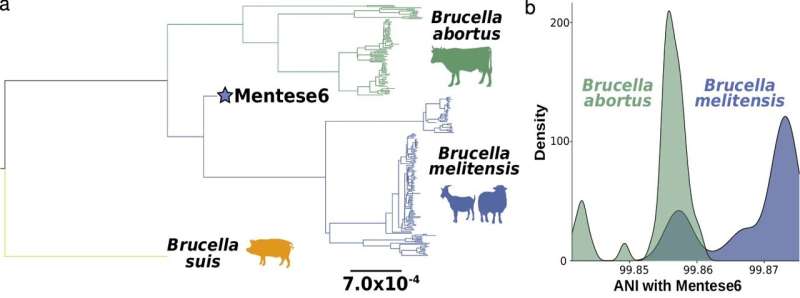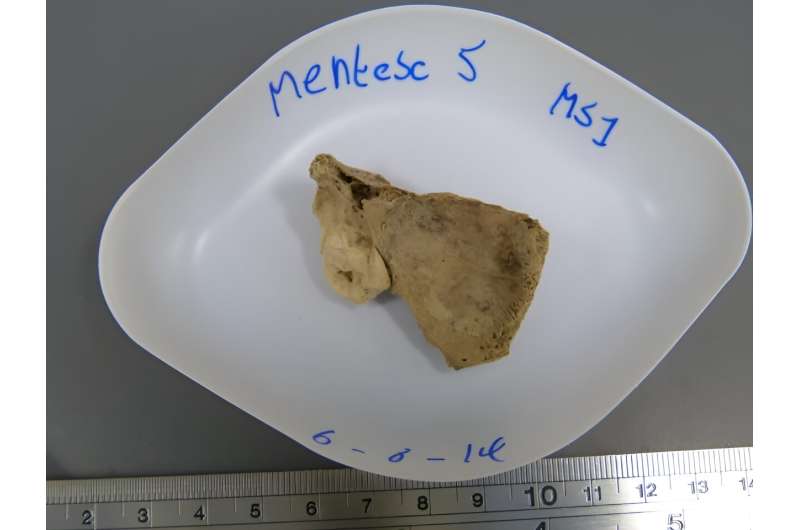This article has been reviewed according to Science X's editorial process and policies. Editors have highlighted the following attributes while ensuring the content's credibility:
fact-checked
peer-reviewed publication
trusted source
proofread
Ancient DNA analyses imply brucellosis pathogen evolved with development of farming

Scientists analyzed ancient DNA extracted from an 8,000-year-old sheep bone and detected the Brucella melitensis pathogen. Brucellosis affects millions of people every year and causes significant harm to the welfare of livestock.
Passed on by the consumption of unpasteurized milk and close contact with infected animals, brucellosis can cause waves of undulating fever and, tragically, the infection-related loss of pregnancy in pregnant women.
Now, researchers have recovered a millennia-old genome of the sheep, goat, and human-infecting pathogen.
Recently published in the journal Nature Communications, the study reveals that the pathogen responsible for most brucellosis infections, Brucella melitensis, existed over 8,000 years ago in Neolithic times.
How long have we lived with disease-causing pathogens? How and when did the pathogens which infect both humans and animals—known as zoonoses—evolve? And did we play a role in their evolution? These are questions which have long challenged researchers, particularly due to the difficulty of studying the deep past.
But recent advances in the field of ancient DNA—the sequencing of genomes from organisms thousands of years in the past, from DNA typically preserved in bones and teeth—have allowed these questions to be directly addressed.

In this study an international team of geneticists and archaeologists succeeded in detecting the Brucella in DNA from an 8,000-year-old sheep bone from Menteşe Höyük, an archaeological settlement in Northwest Türkiye, which shows the pathogen was circulating in herds of the world's first animal farmers.
"Looking for ancient pathogen DNA is like looking for a needle in a haystack," says Louis L'Hôte, Ph.D. candidate in Trinity College Dublin's School of Genetics and Microbiology, and lead author of the study.
"It requires well preserved DNA and the presence of the infectious agent during the life of the animal. We were lucky enough to detect the presence of Brucella melitensis in Menteşe Höyük, which is a sign that the bacteria was infecting livestock during the Neolithic."
Using the genome, the researchers were able to time when Brucella melitensis, which typically infects sheep and goats, evolved from its shared ancestor with Brucella abortus, which mostly infects cattle. They estimate that this happened ~9,800 years ago, in a period known as the Neolithic, when crop and livestock farming first developed.
Intriguingly, this overlaps with when livestock keeping had become more developed, with farming communities keeping a mixture of animals.
"By bringing together animals such as sheep, goat, cattle and pigs, which may rarely have lived in the same spaces together, early livestock farmers may have created an evolutionary melting pot for pathogen host-jumping, says Dr. Kevin Daly, Ad Astra Assistant Professor at University College Dublin (and formerly of Trinity), who supervised the study.
"For as long as we have kept animals as livestock, humanity has risked disease exposure—a problem we still grapple with 10,000 years later," he adds.
More information: Louis L'Hôte et al, An 8000 years old genome reveals the Neolithic origin of the zoonosis Brucella melitensis, Nature Communications (2024). DOI: 10.1038/s41467-024-50536-1
Journal information: Nature Communications
Provided by Trinity College Dublin



















